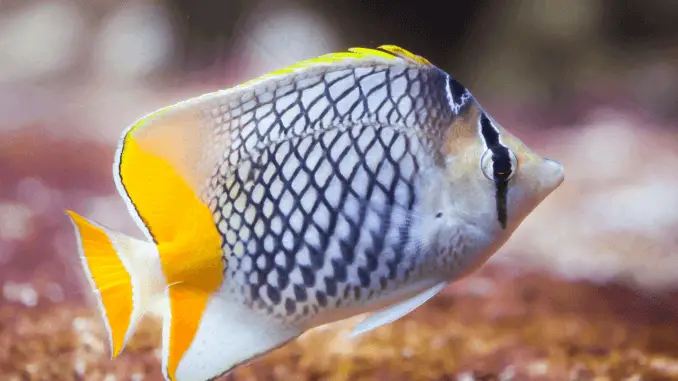
Butterflyfish are some of the most beautiful and exotic colored fish known in the sea.
There are at least 114 recorded species of saltwater butterflyfish, however, under half are them are suitable for home aquariums.
Some species are commonly kept and can adapt to life in an aquarium, and others are near impossible to keep in captivity.
Due to the complexity, time, and effort required to keep butterflyfish, we recommend that only expert aquarists keep them.
TABLE OF CONTENTS
Butterflyfish Facts & Overview
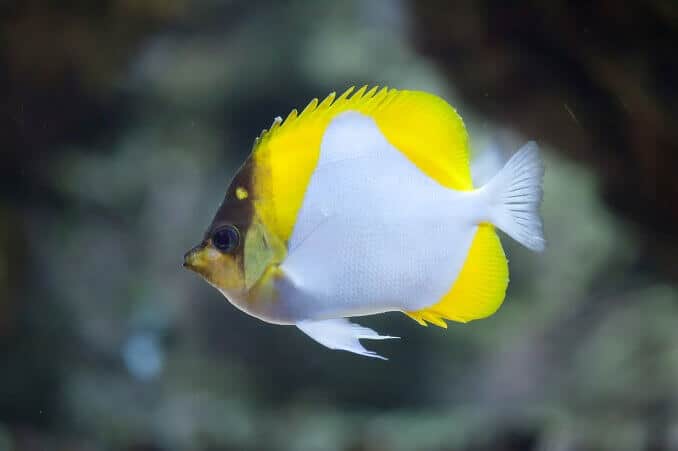
| Category | Rating |
| Care Level: | Depends on species, moderate to difficult |
| Temperament: | Usually peaceful |
| Color: | Vivid patterns in black, white, yellow, orange, red, and silver |
| Lifespan: | 5-10 years |
| Size: | 12-22cm |
| Diet: | Omnivore |
| Family: | Chaetodontidae |
| Minimum Tank Size: | Most species require a 125+ gallon tank |
| Tank Setup: | Plenty of open swimming space, plus rocks and crevices to hide in |
| Compatibility: | Other peaceful community tank fish such as clownfish, damselfish, and tangs |
Butterflyfish are part of the Chaetodontidae family which also includes Bannerfish and Coralfish.
They are one of the most colorful and intricately patterned families of saltwater fish, and aesthetic beauty is one of the top reasons people keep fish.
This small sized marine fish is mostly found on the coral reefs of the Atlantic, Indian and Pacific Oceans, in tropical and subtropical waters. They range from 12 to 22cm (4.7 to 8.7 inches) in length; however some species such as the Saddle Butterflyfish can grow up to 30cm (12 inches).
Butterflyfish are diurnal animals, which means they are active and feed during the day and rest on the coral during the night. They mostly eat plankton, coral and sea anemones.
The smaller species tend to stay in groups, whereas the larger species are usually solitary or swim with their mating partner, with whom they mate for life.
Appearance
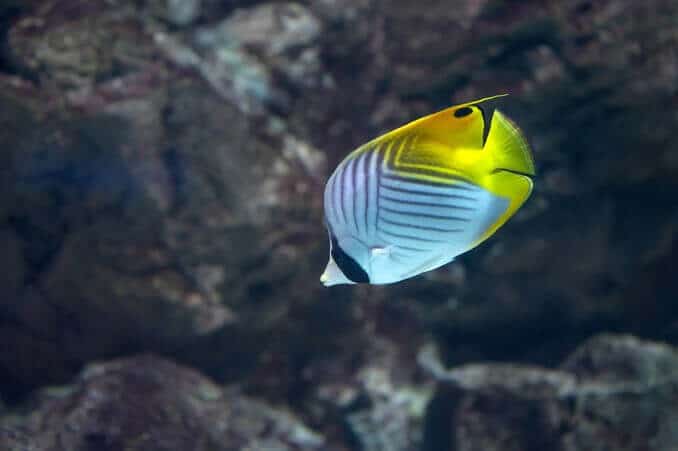
Butterflyfish are some of the more brightly and striking patterned fish in the sea, perhaps this is why they are so popular to aquarists.
Whilst the majority of species have vivid patterns in whites, blues, reds, oranges, yellows, and blacks, some species are duller in color, yet still with intricate patterns.
Many butterflyfish have dark bands across their eyes, and round dots on their flanks which can be confused with eyes to predators. This confuses the predators as to which way the fish is likely to flee.
They have thin, flattened, disk-shaped bodies, with an uninterrupted dorsal fin.
Most species have elongated noses which allow them to reach small crevices to feed.
They closely resemble the Angelfish, however they don’t have elongated noses, they are a lot bigger, and they don’t have the preopercle spines at the gill covers.
Butterflyfish fry (the babies) develop armored plates which protect them from predators when they are so vulnerable. These plates disappear as they reach maturity.
Behavior and Compatibility
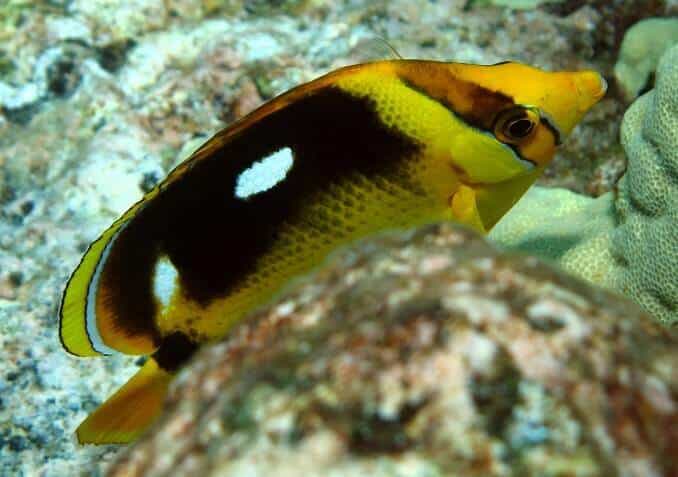
The behavior and compatibilities of the Butterflyfish depends on the species, you should read the species section below for a more detailed look on individual species. For now, we’ll just take a general look at their behaviors.
Butterflyfish generally stay in groups unless they are a particularly territorial species. A solitary Butterflyfish is usually travelling in search of a mate. They are one of the very few fish who find a mate, and then hunt, live and travel together for life.
Butterflyfish are extremely good swimmers, the constant strokes made by their pectoral fins allow them to move quickly and swiftly.
Due to their small size, they are able to hide themselves into crevices which, as well as being beneficial for getting food, lets them hide from predators.
Most Butterflyfish are shy and will be fine in a tank with other peaceful tank mates as long as the tank is large enough and there are plenty of hiding spaces. Some species, in particular the obligate coral feeders, are more territorial and prone to attacking if other species come into their zone.
The more territorial fish are usually fine in pairs or small groups of the same species, but mixing them with other Butterflyfish should generally be avoided.
Ideal tank-makes for Butterflyfish include Clownfish, Damsels, Gobies, Hogfish, Parrotfish, and Tangs.
Habitat and Tank Requirements
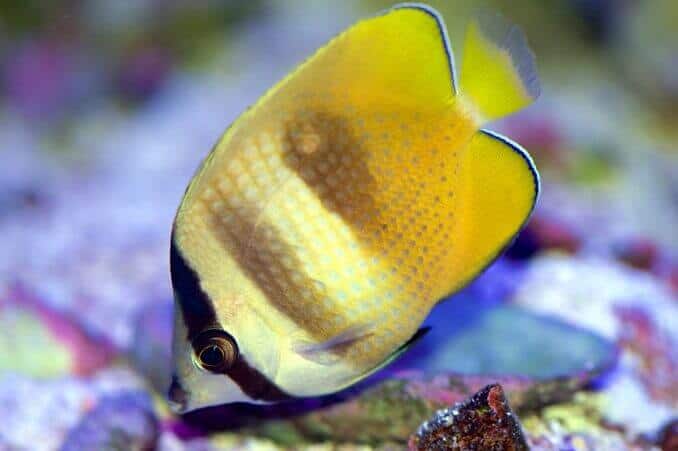
Most Butterflyfish are best kept in fish-only tanks or fish-only live rock tanks.
There are a few species such as the Raccoon Butterflyfish and Merten’s Butterflyfish that would be suitable for a reef tank.
The aquarium should have plenty of hiding places which can be made up of corals and rocks, ideally live rock.
Butterflyfish require large aquariums, some species require a minimum of 75 gallons, and others require at least 150 gallons. This will provide them with plenty of open space for swimming.
All species rely on different tank conditions so you should see the specific species guidance below for pH balance, water hardness and water temperature.
In general, most species require a water temperature between 72-78 OF, carbonate hardness (dKH) of 8-12, and a pH of 8.1-8.4.
Diet
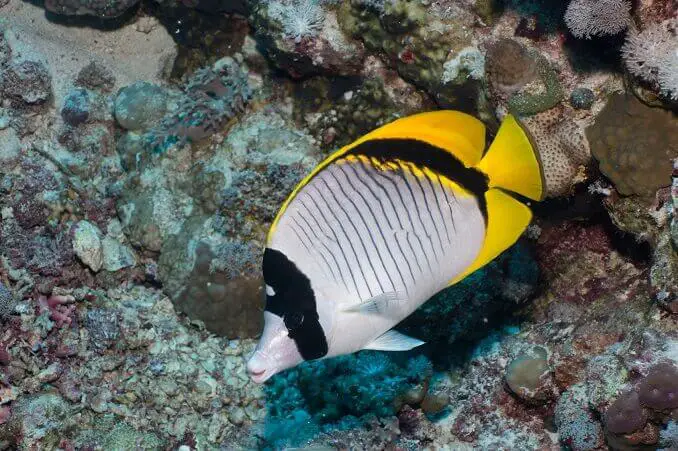
The majority of Butterflyfish have long pointed noses which make them really adept at crevice feeding.
They mainly eat algae, corals and sponges. Some butterflyfish are omnivorous and occasionally, they will eat tiny crustaceans and planktonic animals.
Others live solely off coral polyps, so unless you are able and willing to buy live corals, you’ll want to avoid these species. These species also tend to be the more territorial species.
Butterflyfish, who are not solely coral eaters, still require a varied diet. You should offer them a wide variety of different foods. Just like humans, fish need a balanced diet; too much of one thing is not good.
Their diet should consist of flakes, frozen food (you can get frozen sponge-based foods) live brine shrimp and plankton. They should be fed several times a day.
You might choose to make your own fish food, it is a lot simpler and cheaper than you might expect.
Care
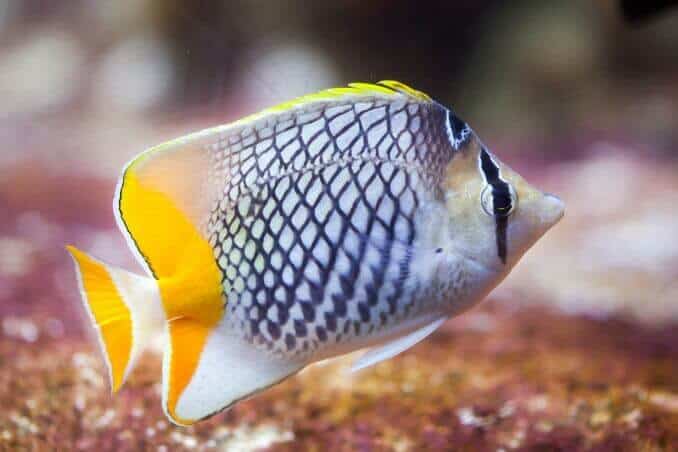
Some species of Butterflyfish are hardy and adapt well to aquarium life, whereas others are near impossible to keep.
Because Butterflyfish are extremely difficult to breed in captivity, it’s likely that your fish will need to adapt to tank life.
They are also quite vulnerable to parasite infections. To reduce this as much as possible, you can keep them in a community tank with cleaner fish.
If you keep the tank conditions right for your fish, they are unlikely to get diseases, however improper care can lead to these diseases:
Dropsy
This bacterial infection infects the fish from the inside out and causes swelling around the stomach area making the scales stick out and causing a pine-cone shape.
The cause of Dropsy is usually over use of salt, poor water conditions, improper diet or internal injuries/tumors.
It’s important to catch Dropsy early, as it is usually fatal if it gets to the stage where they have swelled as described above. Some recommend over the counter medication but this is only usually effective if administered early on.
Nitrite or Nitrate Poisoning
This poisoning happens when tank conditions are not correct and the water is not maintained properly.
Symptoms include loss of appetite, loss of equilibrium, rapid gill movement, listless fish, laying at the bottom of the tank, and in severe cases, the fish curling.
The quickest treatment is to perform small water changes, reduce feeding and increase aeration. The keyword here is gradual. Do everything gradually and slowly.
To prevent poisoning, perform regular maintenance, keep the tank clean and don’t overstock your tank.
Butterflyfish Species
Now we’ve look at an overview of Butterflyfish, let’s take a look at each individual species, their attributes and specific needs.
| Name | Appearance | Stats | Overview |
| Auriga Butterflyfish | Black, White and Yellow. Also known as the Threadfin Butterflyfish. | Care Level: Easy Temperament: Peaceful Tank Size: Min. 125 gallons Tank Conditions: 72-78OF, dKH 8-12, pH 8.2-8.4 | One of the more popular and readily available fish. Hardy and quite shy and peaceful. Should be given plenty of hiding places. Can be kept in a live rock-only tank, though it will pick at the rock. Should be fed meaty items – fish, crustaceans, and mysis shrimp. |
| Copperband Butterflyfish | Long narrow nose, yellow-orange vertical bands with black outlines. False eyespot on the rear of the dorsal fin. Also known as the Orange Stripe Butterfly, Beaker Coralfish or Beaked Butterflyfish. | Care Level: Difficult Temperament: Peaceful Tank Size: Min. 125 gallons Tank Conditions: 72-78OF, dKH 8-12, pH 8.2-8.4 | Very sensitive and peaceful fish. Best kept in a large reef or peaceful community tank. Difficult fish to adapt to an aquarium as they are so shy and hard to feed. May need a variety of foods to start an interest in feeding. |
| Falcula Butterflyfish | White body with a yellow dorsal. A number of narrow black stripes on its side and two patches of black on the dorsal. Black band over the eye and orange coloration towards the posterior. Also known as the Sickle Butterflyfish. Grows up to 8 inches. | Care Level: Moderate Temperament: Semi-aggressive Tank Size: Min.125 gallons Tank Conditions: 72-78 OF, dKH 8-12, pH 8.1-8.4 | Best kept singularly to avoid aggression. Tank mates should be of similar size and temperament. Can be difficult to get them to feed, as with other butterflyfish. Start them on small live foods if so. You can then wean them onto other frozen and dried foods. |
| Fourspot Butterflyfish | Yellow underside, black dorsal fin and two white spots on either side. | Care Level: Moderate Temperament: Peaceful Tank Size: 75 gallons Tank Conditions: 73 -81 OF, pH 8.1-8.4 | Active but shy species. Darts frantically if scared. Good jumpers so handle with care. Depending on the fish, some can find it difficult to adapt to tank life and may be difficult to feed. Peaceful but can become territorial with other smaller fish, especially other butterflyfish species. Most will take meaty frozen food like mysis or brine shrimp combined with algae. |
| Klein’s Butterflyfish | Mostly golden-yellow, either has a black or black and blue eye band. Also known as The Orange Butterflyfish, Sunburst, Brown, Corallicola or Blacklip Butterflyfish. | Care Level: Easy Temperament: Peaceful Tank Size: Min. 120 gallons Tank Conditions: 72-78OF, dKH 8-12, pH 8.1-8.4 | Hardy and peaceful species which adapts to aquarium life well – suitable for beginners. Diet should consist of meaty items such as fish, mysis shrimp, crustaceans and frozen marine preparations. Should be fed three times a day. |
| Lemon Butterflyfish | Mainly yellow with dark spots which form vertical stripes. Black line through its eyes, yellow fins. Also known as the Milletseed Butterflyfish or the Millet Butterflyfish. | Care Level: Moderate Temperament: Peaceful Tank Size: Min. 75 gallons Tank Conditions: 72-78OF, dKH 8-12, pH 8.1-8.4 | Another hardy and not very aggressive species. Can be kept with other non-aggressive fish. Can be kept in small groups, in pairs or singly, but should all be introduced to aquarium at the same time. Usually easy to transition to tank life and will take tank food after a few days. To prevent color loss which usually occurs in captivity, you can feed them color-enhancing and vitamin-enriched foods. |
| Lined Butterflyfish | White body with thin black vertical lines coming down from the dorsal fin. Thick black band at the base of the tail and dorsal fin. Tail, dorsal and anal fins are yellow. | Care Level: Moderate Temperament: Peaceful, aggressive with own species Tank Size: Min. 150 gallons Tank Conditions: 75-82 OF, dKH 8-12, pH 8.2-8.4 | Very sensitive species. Thin and delicate fins. Doesn’t adapt to tank life easily, hard to get them to eat and very shy. One of the larger, more aggressive species. Only recommended for experts given the size they can reach (12 inches). |
| Pearlscale Butterflyfish | Pearly white body with a striking reticulated (net-like) pattern in black. The dorsal and anal fins are a brilliant orange, and the tips of the dorsal fin are highlighted in yellow. Dark oval spot behind the eye band. Grows up to 6 inches. | Care Level: Moderate Temperament: Peaceful Tank Size: Min 70. gallons Tank Conditions: 72-78 OF, dKH 8-12, pH 8.1-8.4 | House with other peaceful fish, can house with same species as long as they are introduced at the same time. Diet: meaty food which can include frozen, fresh or flake food. |
| Pebbled Butterflyfish | Creamy white body, with 5/6 tan lines running vertically. Dark vertical strip across the eye and a black band in the tail fin. Lots of small spots which make a pattern of horizontal and vertical lines. Fairly small fish reaching only 3 ¾ inches. Also known as the Multiband Butterflyfish, the Many Banded Butterflyfish and the Hawaiian Pebble Butterflyfish. | Care Level: Moderate Temperament: Peaceful Tank Size: Min 75 gallons. Tank Conditions: 75-82 OF, dKH 8-12, pH 8.0-8.4 | Coral polyp eater, but can adapt to tank life and some will take typical tank foods. Plenty of rocks and cave to hide in. The tank will also need a good amount of swimming space so there should be lots of open water. Can be aggressive towards other members of its family, would do well in a fish only tank with fish that are not territorial or aggressive. |
| Pyramid Butterflyfish | Yellow and White. Also known as the Yellow Zoster Butterflyfish. | Care Level: Moderate Temperament: Peaceful Tank Size: Min 125 gallons Tank Conditions: 72-78 OF, dKH 8-12, pH 8.1-8.4 | Should be kept singularly, unless you have a few hundred gallon tank in which you can keep three. Get along with other peaceful fish. Water circulation should be brisk, a min of 20 turns per hour. Coral eater and omnivore. Easier to adapt if they are put in the tank as a juvenile and will take some tank fed foods such as live/frozen meaty foods. |
| Raccoon Butterflyfish | Yellow-orange with a darker upper half body. Black patch around eyes, thick white stripe just behind the eyes. | Care Level: Easy Temperament: Peaceful Tank Size: Min 125 gallons Tank Conditions: 72-78 OF, dKH 8-12, pH 8.1-8.4 | Not suitable for a reef tank. Can be difficult to get it to eat, if this occurs, it may be tempted with a small anemone. Once adjusted it will need a meaty diet of crustacean flesh and mysis shrimp several times a day. |
| Saddleback Butterflyfish | Large black ‘saddle’ surrounded by a white border on the upper rear of the body and dorsal fin. Orange on the lower half of its face and bordering the black tail. Light grey base color with blue/grey stripes on the lower half of the body. | Care Level: Moderate Temperament: Semi-aggressive Tank Size: Min 125. gallons Tank Conditions: 72-78 OF, dKH 8-12, pH 8.1-8.4 | Semi-aggressive fish needs plenty of swimming space. Needs a min of 125 gallon tank. Eats coral polyps out in the wild, can adapt to take dried shrimp and brine shrimp. |
| Teardrop Butterflyfish | White base which blends into yellow on the dorsal and median fins. Black vertical stripe through its eyes, and another one at the posterior end. Large black eyespot on its upper side. Grows up to 8 inches. | Care Level: Moderate Temperament: Peaceful Tank Size: Min 125. gallons Tank Conditions: 72-78 OF, dKH 8-12, pH 8.1-8.4 | Coral pickers in the wild, they also eat algae off the rocks and coral, and small marine life. In an aquarium, juveniles usually adapt to tank foods well, adults are a lot more difficult to adapt. Meaty and vegetable diet. |
| Tinkers Butterflyfish | Anterior half is white with black dots on each scale. Posterior half is black. Yellow and Orange face, dorsal fin and tail. Also known as the Tinkeri Butterflyfish and the Hawaiian Butterflyfish. Grows up to 5 ½ inches. | Care Level: Moderate Temperament: Peaceful Tank Size: Min 120. Gallons Tank Conditions: 72-78 OF, dKH 8-12, pH 8.1-8.4 | Found in deep waters where black coral is abundant. Rare and difficult to collect so very expensive. Tank should be moderately lit. Diet consists of meaty items, enriched mysis shrimp, brine shrimp, and vegetables |
| Yellow Longnose Butterflyfish | Yellow body. Head is divided horizontally. The top half is black and the bottom is white. Long and jagged dorsal fins. Blue edging at posterior end. Grows up to 9 inches. | Care Level: Moderate Temperament: Peaceful Tank Size: Min. 125 gallons Tank Conditions: 72-78 OF, dKH 8-12, pH 8.1-8.4 | Best kept singly or as a mated pair. Compatible with other non-aggressive fish, can be kept with other moderately aggressive fish if introduced first. |
We should note here that if you’re looking for information on the African Butterflyfish, this is not in the Chaetodontidae family. It is an entirely different species; it is in the Pantodontidae family and is a freshwater fish with no similarities to the saltwater butterflyfish.
Is the Butterflyfish Suitable for your Aquarium?
Are you looking for a beautiful and bright new addition to your peaceful community tank?
If so, the Butterflyfish could be for you. It’s important to remember that although you may find some species stocked in shops, they are not always easy to care for.
You need to thoroughly research the exact species of Butterflyfish that you intend to get; the required care varies hugely amongst them.
One of the most difficult things will be feeding your Butterflyfish because most of the stock you’ll find will have come straight from their natural habitat and might not be used to eating manufactured flakes or pellets.
Do you still think the Butterflyfish is right for your tank? Make sure you read over these things you shouldn’t put in your tank to ensure it is ready for your Butterflyfish.
Frequently Asked Questions About Butterflyfish
- How do you identify a butterflyfish?
- What do you feed a copperband butterflyfish?
- Can African butterflyfish live together?
- Can you keep different types of butterflyfish together?
- Do butterflyfish have teeth?
- Do butterflyfish lay eggs?
- What body shape does a butterflyfish have?
- Are copperband butterflyfish hard to keep?
- What do you feed butterflyfish?
- Do butterflyfish eat small fish?
- How much does a butterflyfish cost?
- Are butterflyfish fast?
- Are butterflyfish poisonous?
- Why are they called butterflyfish?
- What do butterflyfish need to survive?

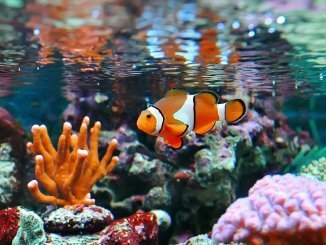
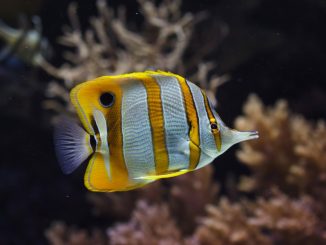
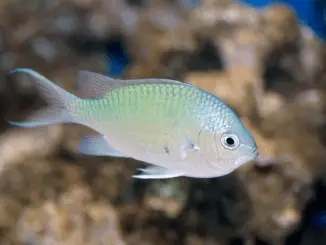
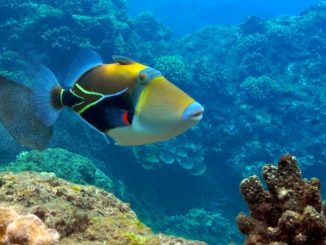
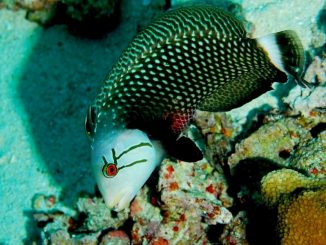
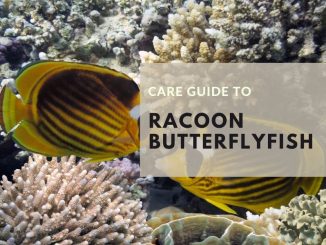
I’m looking at a pearl scale.